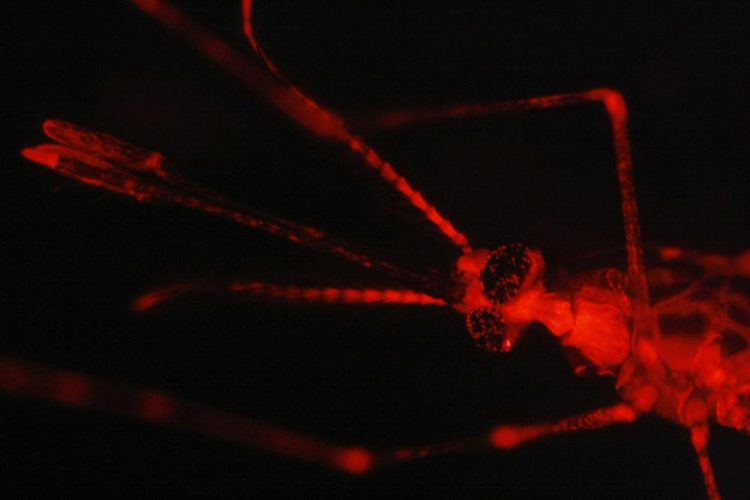Scientist identify new marker for insecticide resistance in malaria mosquitoes

Anopheles gambiae mosquito showing Gal4 directed ubiquitous expression of red fluorescent protein Credit: Adriana Adolfi
For the first time the team characterised three genes (Cyp6m2, Cyp6p3 and Gste2) most often associated with insecticide resistance directly by their overproduction in genetically modified Anopheles gambiae.
LSTM's Dr Gareth Lycett is senior author on a paper published today in the journal PNAS. He explained: “Malaria is resurging again in Africa as mosquitoes become highly resistant to insecticides that are used to create bednets and spray household surfaces.”
To help find the causes of this increased resistance first author, Dr Adriana Adolfi, and her colleagues at LSTM generated genetically modified mosquitoes that overproduce specific enzymes that previous work at LSTM had identified as potential candidates in this process of acquiring insecticide resistance.
This breakthrough work has found that increased production of just these three genes can between them cause the mosquitoes to become resistant to all four classes of public health insecticides currently being used in malaria control.
Dr Lycett continued: “These data validate the particular genes as excellent markers for resistance, giving us much needed tools to monitor the growing problem effectively through molecular testing.
The super-resistant mosquitoes generated are now also being used test new insecticides to find compounds that escape the activity of these enzymes and so can successfully to be incorporated in next generation bednets to again provide effective protection for users and the wider community.”
Media Contact
More Information:
http://dx.doi.org/10.1073/pnas.1914633116All latest news from the category: Life Sciences and Chemistry
Articles and reports from the Life Sciences and chemistry area deal with applied and basic research into modern biology, chemistry and human medicine.
Valuable information can be found on a range of life sciences fields including bacteriology, biochemistry, bionics, bioinformatics, biophysics, biotechnology, genetics, geobotany, human biology, marine biology, microbiology, molecular biology, cellular biology, zoology, bioinorganic chemistry, microchemistry and environmental chemistry.
Newest articles

Trotting robots reveal emergence of animal gait transitions
A four-legged robot trained with machine learning by EPFL researchers has learned to avoid falls by spontaneously switching between walking, trotting, and pronking – a milestone for roboticists as well…

Innovation promises to prevent power pole-top fires
Engineers in Australia have found a new way to make power-pole insulators resistant to fire and electrical sparking, promising to prevent dangerous pole-top fires and reduce blackouts. Pole-top fires pose…

Possible alternative to antibiotics produced by bacteria
Antibacterial substance from staphylococci discovered with new mechanism of action against natural competitors. Many bacteria produce substances to gain an advantage over competitors in their highly competitive natural environment. Researchers…





















